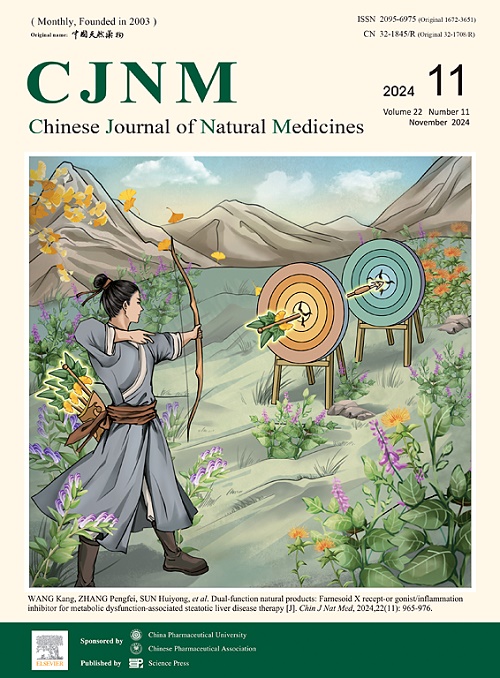Tianxiangdan (TXD) alleviates myocardial ischemia reperfusion-induced ferroptosis through the activation of estrogen receptor alpha (ERα)
IF 4.9
2区 医学
Q1 INTEGRATIVE & COMPLEMENTARY MEDICINE
引用次数: 0
Abstract
Tianxiangdan (TXD), a traditional Chinese herbal remedy, demonstrates efficacy in mitigating myocardial ischemia-reperfusion (I/R)-induced damage. This study employed network pharmacology to evaluate the therapeutic targets and mechanisms of TXD in treating I/R. High-performance liquid chromatography-mass spectrometry (HPLC-MS) identified 86 compounds in TXD. Network pharmacological analysis predicted potential target genes and their modes of action. Cardiac function, ischaemic ST changes, lactate dehydrogenase (LDH), malondialdehyde (MDA), superoxide dismutase (SOD) activity, myocardial fiber, and infarct size were assessed using in vivo and in vitro I/R injury models. Estrogen receptor alpha (ERα) protein expression and estradiol (E2) levels were measured to confirm TXD's impact on estrogen levels and ERα expression. To examine if TXD reduces I/R injury through ERα, an AZD group (300 nmol·L−1 AZD9496 and 15% TXD serum) was compared to a TXD group (15% TXD serum). The study hypothesized that TXD upregulates the ERα-mediated iron metamorphosis pathway. I/R injury-induced ferroptosis was identified using a Fer-1 group (1.0 μmol·L−1 Fer-1 and 15% TXD serum) to elucidate the potential association between ferroptosis and ERα proteins. A DCFH-DA probe detected reactive oxygen species (ROS) and Fe2+, while Western blotting assessed target protein expression. Both in vitro and in vivo experiments demonstrated that TXD attenuated I/R injury by reducing elevated ST-segment levels, improving cardiac injury biomarkers (LDH, MDA, and SOD), alleviating pathological features, and preventing I/R-induced loss of cell viability in vitro. The effects and mechanisms of TXD on I/R injury-associated ferroptosis were investigated using I/R-induced H9c2 cells. The TXD group showed significantly decreased ROS and Fe2+ levels, while the AZ group (treated with AZD9496) exhibited increased levels. The TXD group demonstrated enhanced expression of ERα and glutathione peroxidase 4 (GPX4), with reduced levels of P53 protein and ferritin-heavy polypeptide 1 (FTH1). The AZ group exhibited contrasting effects on these expression levels. The literature indicated a novel connection between ERα and ferroptosis. TXD activates the ERα signaling pathway, promoting protection against I/R-induced myocardial cell ferroptosis. This study provides evidence supporting TXD use for myocardial ischemia treatment, particularly in older female patients who may benefit from its therapeutic outcomes.
天香丹(TXD)通过激活雌激素受体α (ERα)减轻心肌缺血再灌注诱导的铁下垂。
中药天香丹具有减轻心肌缺血再灌注(I/R)损伤的作用。本研究采用网络药理学方法对TXD治疗I/R的靶点及机制进行了评价。高效液相色谱-质谱联用(HPLC-MS)鉴定出黄芪丹参中86种化合物。网络药理学分析预测了潜在的靶基因及其作用方式。采用体内和体外I/R损伤模型评估心功能、缺血性ST改变、乳酸脱氢酶(LDH)、丙二醛(MDA)、超氧化物歧化酶(SOD)活性、心肌纤维和梗死面积。测定雌激素受体α (ERα)蛋白表达和雌二醇(E2)水平,以证实TXD对雌激素水平和ERα表达的影响。为了研究TXD是否通过ERα减轻I/R损伤,将AZD组(300 nmol·L-1 AZD9496和15% TXD血清)与TXD组(15% TXD血清)进行比较。本研究假设TXD上调er α介导的铁变态途径。采用铁-1组(1.0 μmol·L-1铁-1和15% TXD血清)鉴定I/R损伤诱导的铁下垂,以阐明铁下垂与ERα蛋白之间的潜在关联。DCFH-DA探针检测活性氧(ROS)和Fe2+, Western blotting检测靶蛋白表达。体外和体内实验均表明,TXD通过降低st段升高水平、改善心脏损伤生物标志物(LDH、MDA和SOD)、缓解病理特征和防止I/R诱导的细胞活力丧失来减轻I/R损伤。采用I/R诱导的H9c2细胞,研究TXD对I/R损伤相关性铁凋亡的作用及机制。TXD组ROS和Fe2+水平显著降低,而AZD9496组ROS和Fe2+水平升高。TXD组ERα和谷胱甘肽过氧化物酶4 (GPX4)表达增强,P53蛋白和铁蛋白重多肽1 (FTH1)水平降低。AZ组在这些表达水平上表现出截然不同的影响。文献表明ERα与铁下垂之间存在新的联系。TXD激活ERα信号通路,促进对I/ r诱导的心肌细胞铁下垂的保护。本研究提供了支持TXD用于心肌缺血治疗的证据,特别是对于可能受益于其治疗结果的老年女性患者。
本文章由计算机程序翻译,如有差异,请以英文原文为准。
求助全文
约1分钟内获得全文
求助全文
来源期刊

Chinese Journal of Natural Medicines
INTEGRATIVE & COMPLEMENTARY MEDICINE-PHARMACOLOGY & PHARMACY
CiteScore
7.50
自引率
4.30%
发文量
2235
期刊介绍:
The Chinese Journal of Natural Medicines (CJNM), founded and sponsored in May 2003 by China Pharmaceutical University and the Chinese Pharmaceutical Association, is devoted to communication among pharmaceutical and medical scientists interested in the advancement of Traditional Chinese Medicines (TCM). CJNM publishes articles relating to a broad spectrum of bioactive natural products, leading compounds and medicines derived from Traditional Chinese Medicines (TCM).
Topics covered by the journal are: Resources of Traditional Chinese Medicines; Interaction and complexity of prescription; Natural Products Chemistry (including structure modification, semi-and total synthesis, bio-transformation); Pharmacology of natural products and prescription (including pharmacokinetics and toxicology); Pharmaceutics and Analytical Methods of natural products.
 求助内容:
求助内容: 应助结果提醒方式:
应助结果提醒方式:


